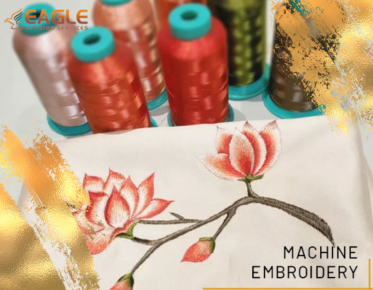The Importance of Post-Embroidery Digitizing Review
Embroidery is a
meticulous craft, blending artistry and technology into stunning fabric
masterpieces. However, the journey from a digital design to a beautifully
embroidered piece doesn’t end with digitizing. In fact, the post-embroidery
digitizing review is where the real magic happens. This crucial step ensures
that the design not only looks great on screen but translates perfectly onto
fabric. By taking the time to evaluate and refine your designs, you can enhance
quality, improve functionality, and ultimately create stunning embroidered
products that stand the test of time.
Why Post-Digitizing Review Matters for Quality Control
Quality control
is the backbone of any successful embroidery project. The post-digitizing
review serves as a safety net, allowing designers to identify and rectify
issues before production begins. By meticulously examining the design, stitch
types, and overall appearance, you can catch errors that might lead to
unsatisfactory outcomes. This attention to detail not only elevates the final product
but also enhances your reputation as a skilled embroiderer.
Setting Up for a Successful Review
Creating
a Comfortable Workspace for Design Evaluation
Before diving
into the review, it’s essential to establish a conducive workspace. A
clutter-free area with ample lighting and comfortable seating sets the tone for
focused evaluation. Surround yourself with inspirational materials, tools, and
your design samples to facilitate a seamless review process. This environment
will help you concentrate and approach the design with a clear mind.
Gathering
All Necessary Materials: Samples and Tools
Preparation is
key. Assemble all relevant materials, including fabric samples, thread colors,
and any previous designs that might serve as references. Having these tools at
your disposal allows for a comprehensive evaluation and aids in making informed
decisions. A well-prepared workspace ensures that you can tackle the review
process efficiently and effectively.
Establishing
Clear Goals for the Review Process
Before you begin,
outline specific objectives for your review. Are you focusing on stitch
quality, color accuracy, or overall design coherence? Having clear goals allows
you to maintain a structured approach, ensuring that you cover all critical
aspects of the design. This focused evaluation fosters a more productive review
session, leading to actionable insights.
First Impressions: The Initial Design Assessment
Taking
a Step Back: Viewing the Design Objectively
The first step in
the review process is to take a step back and view your design with fresh eyes.
This moment of detachment enables you to assess the work objectively, allowing
you to spot potential flaws or areas for improvement. It’s vital to distance
yourself from the creative process temporarily to gain a clearer perspective on
the design’s strengths and weaknesses.
Evaluating
Overall Visual Appeal and Impact
Once you’ve
stepped back, focus on the overall visual appeal. Does the design catch the
eye? Is there a harmonious flow to the elements? Evaluate the impact of the
design as a whole, considering how it communicates your intended message. A
compelling design should evoke emotions and leave a lasting impression on its
audience.
Noticing
Immediate Red Flags in the Design
As you assess the
design, be vigilant for immediate red flags. Look for inconsistencies in color,
irregular stitch patterns, or any elements that seem out of place. Identifying
these issues early on will save time and resources later in the process,
allowing you to make necessary adjustments before moving forward.
Detail-Oriented Review: Examining the Stitching
Assessing
Stitch Density: Too Tight or Too Loose?
Stitch density
plays a crucial role in the quality of your embroidery. Too tight, and the
fabric may pucker or distort; too loose, and the design can appear flimsy.
Carefully assess the stitch density throughout the design, ensuring it strikes
a balance that enhances both aesthetics and durability. This meticulous
examination ensures that the design will withstand the test of time, regardless
of the fabric.
Analyzing
Stitch Direction and Its Effect on Texture
The direction of
stitches can dramatically influence the texture and appearance of your
embroidery. Evaluate how the stitch direction interacts with the design
elements. Are they aligned to create depth, or do they clash and appear
chaotic? Adjusting stitch direction can enhance the overall texture and visual
interest, giving your embroidery a professional finish.
Checking
for Consistency in Stitch Types Throughout the Design
Consistency is
key to a polished look. Review the various stitch types used in the design,
ensuring they complement one another seamlessly. A haphazard mix of stitches
can detract from the overall aesthetic and may lead to confusion in execution.
By maintaining a consistent approach, you elevate the design's professionalism
and appeal.
Color Considerations: Evaluating Your Palette
How
to Ensure Color Accuracy and Consistency
Color plays a
pivotal role in the success of your embroidery design. To ensure accuracy,
compare your digital colors with physical thread samples. This step is crucial,
as colors can appear differently on screen than they do in reality. Strive for
consistency across your palette to ensure a cohesive look that aligns with your
brand or project goals.
The
Importance of Testing Colors on Different Fabrics
Different fabrics
can absorb and reflect colors in unique ways. Conduct tests by stitching out
your design on various fabrics to evaluate how colors appear in real life. This
testing will help you make informed decisions about color choices, ensuring
that the final product meets your expectations and looks stunning on the chosen
material.
Adjusting
Colors for Better Contrast and Visibility
Contrast is
essential for visibility and impact. Evaluate how well your colors work
together, especially in terms of visibility from a distance. Adjust colors as
necessary to ensure that the design stands out and captures attention. This
attention to detail can make all the difference in the success of your
embroidery project.
Design Alignment: Ensuring Precision
Checking
Alignment of Design Elements: Are They Straight?
Alignment is
vital for a professional finish. Carefully check that all elements of your
design are aligned correctly and straight. Misalignments can create an
unbalanced look, detracting from the overall appeal. Utilize grids or alignment
tools to ensure everything is in its rightful place before moving to
production.
How
to Ensure Proper Placement on Garments
When preparing
designs for specific garments, placement is crucial. Consider how the design
will sit on the fabric and ensure it’s positioned for maximum impact. Take the
time to mark placement guides or use templates to maintain consistency across
multiple items. This diligence in preparation enhances the quality of your
finished products.
Making
Adjustments for a Balanced Composition
A well-composed
design is visually pleasing and harmonious. Assess the overall balance of your
design and make adjustments as needed. This might involve repositioning
elements, altering sizes, or modifying stitch types to achieve a more cohesive
look. A balanced composition elevates the design, creating a polished and
professional final product.
Functionality Check: Testing the Design
Conducting
a Stitch-Out Test: What to Look For
A stitch-out test
is a crucial step in the review process. By running the design on an embroidery
machine, you can see firsthand how it performs in real-time. Look for any
irregularities, such as thread breaks, puckering, or misalignments during the
stitching process. This practical assessment allows you to pinpoint issues that
may not be visible in the digital design.
Evaluating
the Design’s Performance on Different Fabrics
Different fabrics
can behave differently under the needle. Test your design on a variety of
materials to evaluate how it performs. Pay attention to how the stitches hold
up, whether the colors pop, and if there are any fabric-specific issues. This
testing ensures that your design is versatile and adaptable to different
applications.
Ensuring
the Design Works for Various Embroidery Techniques
Your design
should be compatible with various embroidery techniques, from traditional fills
to intricate appliqués. Assess whether the design lends itself well to these
techniques. If adjustments are necessary, make them before moving forward with
production to ensure that the outcome aligns with your artistic vision.
Common Issues to Watch For
Identifying
and Addressing Common Stitching Problems
During your
review, be on the lookout for common stitching problems. These may include
thread breaks, uneven stitches, or skipped stitches. Identifying these issues
early allows you to implement solutions before they affect your final product,
saving you time and frustration in the long run.
How
to Spot and Fix Thread Breaks or Fraying
Thread breaks and
fraying can significantly impact the quality of your embroidery. During your
stitch-out tests, closely observe the stitching process for any signs of
breakage. If you notice issues, adjust tension settings, or consider using
different thread types to ensure a smooth and uninterrupted stitching
experience.
Troubleshooting
Misalignments and Gaps in the Design
Misalignments and
gaps can mar an otherwise beautiful design. If you spot these issues during
your review, make note of them and plan for adjustments. Whether it’s
fine-tuning the digitizing process or adjusting stitch placement, addressing
these concerns proactively will lead to a more polished final result.
Gathering Feedback: Involving Others in the Process
The
Value of Getting a Second Opinion
Bringing others
into the review process can provide valuable insights. A fresh pair of eyes can
catch details you may have missed and offer constructive feedback that enhances
your design. Encourage open communication and embrace diverse perspectives to
refine your work further.
How
to Collect Constructive Criticism Effectively
When seeking
feedback, be clear about what aspects you want input on. Providing specific
questions or areas of focus helps others give you constructive criticism that
is actionable. This targeted approach ensures that you gather valuable insights
that can lead to meaningful improvements in your design.
Collaborating
with the Digitizer for Improvements
Your digitizer is
an invaluable resource in the review process. Collaborate closely with them to
address any concerns or make necessary adjustments based on feedback. This
partnership ensures that your design maintains its integrity while
incorporating enhancements that lead to a superior final product.
Refining Your Design: Making Necessary Adjustments
Tips
for Editing Your Design Files Post-Review
Once you’ve
gathered feedback and identified areas for improvement, it’s time to refine
your design files. Keep edits simple and straightforward to avoid compromising
quality. Utilize design software features effectively to implement changes and
maintain the integrity of your original vision.
How
to Implement Changes Without Compromising Quality
Implementing
changes requires a delicate balance. Ensure that adjustments enhance rather
than detract from the overall design. This may involve adjusting stitch
density, color values, or element placement. Each change should contribute to
the design's overall appeal and functionality.
Keeping
Track of Revisions: Best Practices
As you make
edits, it’s vital to keep track of revisions. Create a clear system for
documenting changes, whether it’s through version control in your design
software or a dedicated log. This practice helps you maintain organization and
ensures that you can refer back to previous versions if needed.
Embarking on the post-embroidery digitizing review is a journey toward excellence. By embracing this process, you enhance your designs, ensuring they meet high standards of quality and functionality. The long-term benefits of meticulous attention to detail will resonate in your work, leading to stunning embroidered pieces that leave a lasting impression. So, take the time to review, refine, and perfect your embroidery designs—the results will speak for themselves.



